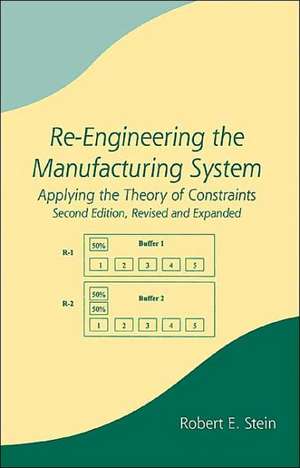Re-Engineering the Manufacturing System: Applying the Theory of Constraints, Second Edition
Autor Robert E. Steinen Limba Engleză Hardback – 3 iun 2003
Preț: 767.64 lei
Preț vechi: 1029.42 lei
-25% Nou
Puncte Express: 1151
Preț estimativ în valută:
146.91€ • 152.97$ • 124.16£
146.91€ • 152.97$ • 124.16£
Comandă specială
Livrare economică 14-28 februarie
Doresc să fiu notificat când acest titlu va fi disponibil:
Se trimite...
Preluare comenzi: 021 569.72.76
Specificații
ISBN-13: 9780824742652
ISBN-10: 0824742656
Pagini: 384
Ilustrații: illustrations, bibliography, index, glossary
Dimensiuni: 152 x 229 x 23 mm
Greutate: 0.64 kg
Ediția:Revizuită
Editura: CRC Press
Colecția CRC Press
ISBN-10: 0824742656
Pagini: 384
Ilustrații: illustrations, bibliography, index, glossary
Dimensiuni: 152 x 229 x 23 mm
Greutate: 0.64 kg
Ediția:Revizuită
Editura: CRC Press
Colecția CRC Press
Public țintă
Professional and Professional Practice & DevelopmentCuprins
Definition and Design: an introduction; visiting the traditional system; synchronization versus optimization; establishing the characteristics of an information system; defining the structure; identifying the constraint; exploitation; subordination;buffer management; supporting the decision process; making strategic decisions; modifying the current system. Implementation: implementing a TOC-based information system; implementing an ERP system to improve profit; critical chain project management;scheduling the multiproject environment. Appendices: ERP implementation at ABC company; glossary of TOC terms.
Notă biografică
Robert E. Stein (Consultant, Cedar Park, Texas, USA) (Author)
Descriere
An information systems trailblazer in the domains of decision support and factory and supply chain synchronization, the second edition of Re-Engineering the Manufacturing System stays true to its title, once again bestowing uniquely straightforward instructions for designing, installing, and operating manufacturing information systems. This updated and expanded source takes care to clarify the often blurred concepts of synchronization and optimization and offers implementation advice from four discrete angles to yield better bottom-line results. It shows how to exploit an information system, rolling ERP system implementation into the TOC framework to promote profit materialization.
